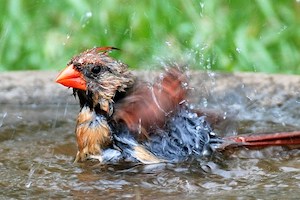
By Terry W. Johnson
With daily temperatures soaring into the 90s and heat indexes topping 100, it seems as if everyone is talking about the weather. While we cannot do anything about the torrid temperatures, we are all trying to stay as cool as possible. This includes spending as much time as possible indoors and enjoying the benefits of air conditioning, limiting our activities during the heat of the day, wearing lightweight clothes, drinking plenty of liquids and even taking a dip at our favorite state park, river, lake or pool.
At the same time, you can be sure that the birds in our backyards are also affected by the temperatures, which sometimes seem more fitting for the Mojave Desert than for Georgia. Yet, while birds cannot escape the heat like we can, their unique physical adaptations and behavior enable them to weather it.
Throughout summer’s heat waves, my wife and I have often been fascinated by watching how the birds in our backyard deal with the heat.
The first thing that we’ve noticed is that they are far less vocal and active during the heat of the day than they were compared to only a few weeks earlier when temperatures were much lower. Restricting activity when temperatures peak reduces the amount of heat their body produces and reduces their need for water. Nowadays, the activity around our feeders stocked with birdseed primarily takes place early and late in the day when temperatures are significantly lower. At midday, we have been seeing few birds at the feeders.
Also, the wood thrush that had been serenading us throughout the day with its flute-like song now sings only early and late. The same is true of the catbirds, brown thrashers, mockingbirds, cardinals and orchard orioles.
Long before the sun reaches its zenith these accomplished songsters have retreated to cooler, shady spots, along with many of their fellow feathered residents. The temperature within these leafy bowers can be as much as 15 degrees Fahrenheit cooler than in an open sunny spot.
Sweating helps cool our bodies. However, since birds do not have any sweat glands, they must use other means to eliminate excess body heat. One way they do this is by panting. As a bird pants, cool air rapidly passes into its lungs and hot air passes out. Since the air taken into their lungs doesn't mix with the air being exhaled, the birds cool more rapidly.
Birds also lose heat through featherless areas such as their legs, feet and even the skin around their eyes. Recent research suggests that, at least for some birds such as seaside sparrows (residents of the Georgia coast) and toucans, heat may also be lost through their bills.
Lately, we have seen catbirds fluttering their wings. Birds will often puff out their feathers and flutter their wings to increase air circulation around their skin to enhance heat loss.
During summer, people often wear tank tops, tee shirts and other thin apparel. Similarly, some species of birds have fewer feathers in summer than winter. This can really help birds, which have an average body temperature of 105 degrees Fahrenheit or higher, stay cool on days when temperatures soar into the 90s and beyond.
Some birds are even known to perch with their lightest colored feathers facing the sun. Since light-colored feathers reflect more heat than dark feathers, this also helps birds avoid overheating.
Like us, birds also often increase the amount of water that they drink on a hot day. They will also bathe more often.
It is truly amazing how water can attract birds when temperatures are high. For example, one afternoon a couple of weeks ago, I replenished the water that had evaporated from the birdbath in front of my office. Less than 20 minutes later, birds began arriving to drink and bathe. The first bather was a female orchard oriole. Over the next hour, the bath was visited by a gray catbird, male and female bluebirds, house finches, and cardinals. In one instance, a bluebird, orchard oriole and gray catbird were all belly deep in the cool water at the same time.
If you have never seen a bird bathe, you are missing a real treat. If we bathed like a bird, we would splash water over the entire bathroom. The birds hop into the water and begin rapidly flapping their wings. This causes the water to fly everywhere. In short order, they are soaked to the skin and look totally bedraggled.
If you want to help your bird neighbors deal with the stress of the heat, keep a birdbath full of clean water. Then sit back and watch. From bathing to becoming less active when temperatures soar, birds are uniquely equipped to cope with our near-tropical weather.
Terry W. Johnson is a former Nongame program manager with the Wildlife Resources Division and executive director of The Environmental Resources Network, or TERN, friends group of the division’s Nongame Conservation Section. (Permission is required to reprint this column.) Learn more about TERN, see previous “Out My Backdoor” columns, read Terry’s Backyard Wildlife Connection blog and check out his latest book, “A Journey of Discovery: Monroe County Outdoors.”



















